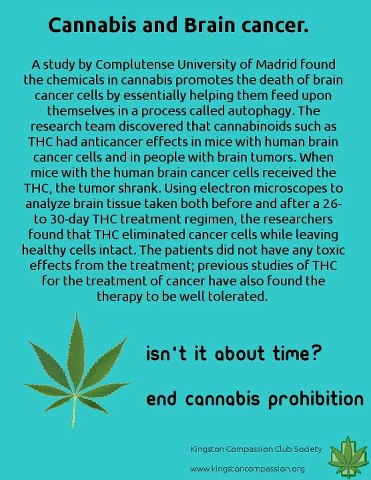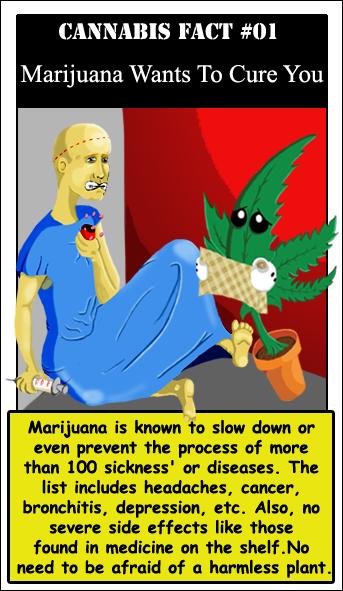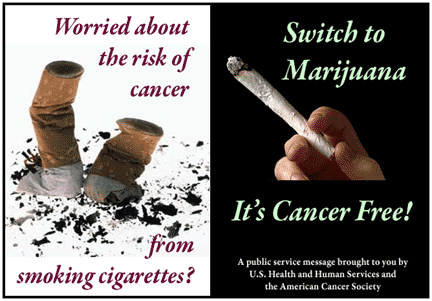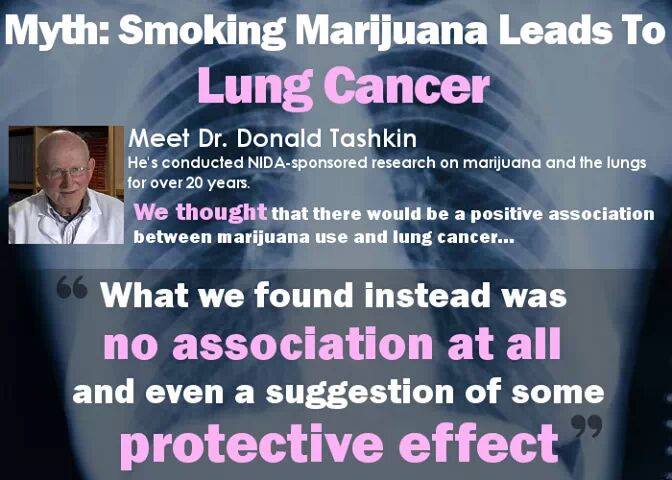|
|
|




The US Government has known since 1974 that Cannabis cures Cancer. In '72 Richard Nixon wanted a larger budget for his war on drugs.
He thought that if he proved Cannabis caused lung cancer like cigarettes do, he would get the support he needed.
He gave the Medical College of Virginia 2 years to do a study on the effects of THC on the body. In '74 the study was completed. It turns out, THC when ingested in highly concentrated forms (such as eating Cannabis oil) will attack any mutated cells in your body while strengthening and rejuvenating the healthy cells. They found the PERFECT cure for Cancer. It worked fast, it worked well, it worked on many different forms of Cancer in ALL stages and it had ZERO harmful side effects.
(Unlike Chemo which deteriorates your entire body and kills 1 in 5 patients.Not only that, but it dissolves ALL forms of tumors and can even combat super-bugs like MRSA.) When Richard Nixon saw the results of the study he was FURIOUS.
He threw the entire report in the trash and deemed the study classified.Mary Jane, Tobacco, & cigarettes; Info on comparison of MJ and tobacco and cigarette additives.
So, you thought it was the tar that caused cancer?


Think again. Cigarette companies will have you believing anything just as long as you continue to buy their products.
The fact is, although insoluble tars are a contributing factor to the lung cancer danger present in today's cigarettes, the real danger is radioactivity. According to U.S. Surgeon General C. Everette Koop (on national television, 1990) radioactivity, not tar, accounts for at least 90% of all smoking related lung cancer.How does radioactivity get into a cigarette?
The tobacco leaves used in making cigarettes contain radioactive material, particularly lead-210 and polonium-210. The radionuclide content of tobacco leaves depends heavily on soil conditions and fertilizer use. Tobacco crops grown in the United States are fertilized by law with phosphates rich in radium 226. Radium 226 breaks down into two long lived elements -- lead 210 and polonium 210. Soils that contain elevated radium lead to high radon gas emanations rising into the growing tobacco crop. Radon rapidly decays into a series of solid, highly radioactive metals (radon decay products). These metals cling to dust particles which in turn are collected by the sticky tobacco leaves. Fine, sticky hairs (called trichomes) on both sides of tobacco leaves grab airborne radioactive particles. For example, phosphate fertilizers, favored by the tobacco industry, contain radium and its decay products (including lead-210 and polonium-210). When phosphate fertilizer is spread on tobacco fields year after year, the concentration of lead-210 and polonium-210 in the soil rises.
Studies have shown that lead 210 and polonium 210 deposits accumulate in the bodies of people exposed to cigarette smoke. Data collected in the late 1970's shows that smokers have three times as much of these elements in their lower lungs as non smokers. Smokers also show a greater accumulation of lead 210 and polonium 210 in their skeletons, though no studies have been conducted to link these deposits with bone cancer. Polonium 210 is the only component of cigarette smoke which has produced tumors by itself in inhalation experiments with animals.
When a smoker inhales tobacco smoke, the lungs react by forming irritated areas in the bronchi. All smoke produces this effect. However, although these irritated spots are referred to as 'pre-cancerous' lesions, they are a perfectly natural defense system and usually go away with no adverse effects. Insoluble tars in tobacco smoke can slow this healing process by adhering to lesions and causing additional irritation. In addition, tobacco smoke causes the bronchi to constrict for long periods of time, which obstructs the lung's ability to clear itself of these residues.Polonium 210 and lead 210 in tobacco smoke show a tendency to accumulate at lesions in specific spots, called bifurcations, in the bronchi. When smoking is continued for an extended period of time, deposits of radioactivity turn into radioactive 'hot spots' and remain at bifurcations for years. Polonium 210 emits highly localized alpha radiation which has been shown to cause cancer. Since polonium 210 has a half life of 21.5 years, it can put an ex-smoker at risk for years after he or she quits. Experiments measuring the level of polonium 210 in victims of lung cancer found that the level of 'hot spot' activity was virtually the same in smokers and ex-smokers even though the ex-smokers had quit five years prior to death.
Over half of the radioactive materials emitted by a burning cigarette are released into the air, where they can be inhaled by nonsmokers. In addition to lead 210 and polonium 210 it has been proven that tobacco smoke can cause airborne radioactive particles to collect in the lungs of both smokers and nonsmokers exposed to secondhand smoke. Original studies conducted on uranium miners which showed an increased risk of lung cancer due to exposure to radon in smokers have been re-run to evaluate the radioactive lung cancer risk from indoor air radon. It turns out that tobacco smoke works as a kind of 'magnet' for airborne radioactive particles, causing them to deposit in your lungs instead of on furniture. (Smoking indoors increases lung cancer risks greatly.)
It has been estimated that the total accumulated alpha radiation exposure of a pack-a-day indoor smoker is 38 to 97 rad by age 60. (Two packs a day yields up to 143 rad, and non-smokers receive no more than 17 rad.) An exposure of 1 rad per year yields a 1% risk of lung cancer (at the lowest estimate.)
Don't smoke. Or if you do, smoke lightly, outdoors, and engage frequently in activities which will clear your lungs. Imported India tobacco has less than half the radiation content of that grown in the U.S.Kicking the nicotine habit is not easy, and nobody has the right to expect it of you. Often physical addictions are reinforced by emotional and psychological needs. Filling or coming o terms with those needs can give you the inspiration and added freedom to succeed. Most of all, inform yourself, even if the information is disturbing. You are a lot less likely to be taken in by tobacco advertising once you know the facts.
Nicotine, the active ingredient in tobacco smoke, has long been known to be highly addictive. Decades of tobacco industry internal documents reveal numerous acknowledgments of the addictiveness of smoking. In fact, doctors and pharmacologists are not in consensus as to which is more addictive -- nicotine, or heroin. Physical addiction occurs when a chemical becomes essential for the body or metabolism to function. In other words, a substance is said to be physically addictive if extended use results in a build up of tolerance in the body to the extent that discontinuing use of the substance results in negative side effects. Called "withdrawal symptoms," these consequences can include anxiety, stress, trauma, depression and physical conditions such as shakes or nausea. It is to avoid these consequences that an addict will keep using his or her substance.
In addition to being addictive, nicotine is also a toxin (i.e. lethal if ingested in sufficient quantities.) Nicotine has been shown to have a negative effect on the heart and circulatory systems, causing a constriction in veins and arteries which may lead to a stroke or heart attack. In fact, nicotine is so poisonous that smokers who ignore their doctor's advice and continue to smoke while using dermal nicotine patches have managed to overdose and die of heart seizure.Many people think smoking marijuana is just as harmful as smoking tobacco, but this is not true. Those who hold that marijuana is equivalent to tobacco are misinformed. Due to the efforts of various federal agencies to discourage use of marijuana in the 1970's the government, in a fit of "reefer madness," conducted several biased studies designed to return results that would equate marijuana smoking with tobacco smoking, or worse.
For example the Berkeley carcinogenic tar studies of the late 1970's concluded that "marijuana is one-and-a-half times as carcinogenic as tobacco." This finding was based solely on the tar content of cannabis leaves compared to that of tobacco, and did not take radioactivity into consideration. (Cannabis tars do not contain radioactive materials.)
1)Most marijuana smokers smoke the bud, not the leaf, of the plant. The bud contains only 33% as much tar as tobacco.
2) Marijuana smokers do not smoke anywhere near as much as tobacco smokers, due to the psychoactive effects of cannabis.
3) Not one case of lung cancer has ever been successfully linked to marijuana use.
4) Cannabis, unlike tobacco, does not cause any narrowing of the small air passageways in the lungs.
In fact, marijuana has been shown to be an expectorant and actually dilates the air channels it comes in contact with. This is why many asthma sufferers look to marijuana to provide relief. Doctors have postulated that marijuana may, in this respect, be more effective than all of the prescription drugs on the market. Studies even show that due to marijuana's ability to clear the lungs of smog, pollutants, and cigarette smoke, it may actually reduce your risk of emphysema, bronchitis, and lung cancer. Smokers of cannabis have been shown to outlive non- smokers in some areas by up to two years. Medium to heavy tobacco smokers will live seven to ten years longer if they also smoke marijuana.
Cannabis is also radically different from tobacco in that it does not contain nicotine and is not addictive.

The psychoactive ingredient in marijuana, THC, has been accused of causing brain and genetic damage, but these studies have all been dis-proven.
In fact, the DEA's own Administrative Law Judge Francis Young has declared that "marijuana in its natural form is far safer than many foods we commonly consume."The disturbing thing about all of this information is that the majority of Americans are as yet unaware of the radioactive risk in cigarettes. In fact, many professionals: doctors, scientists and health administrators, either have never heard of polonium 210 or consider it to be just another scare story.
Why is this information so hard to come by?When the studies were first released in the late 70's, many magazines were unable to print articles because their main advertisers, cigarette companies, threatened to pull support if they published the facts. Although network news did pick up the story, virtually nothing came out in print. Those who heard were hard pressed to produce collaborating evidence, and were eventually convinced it was nothing to worry about.
The power of the cigarette industry to suppress information goes far beyond magazines, however. A well financed tobacco lobby has been very active in the United States Congress for decades procuring subsidies and fighting laws and proposed research which could hurt the American tobacco industry. Tobacco interests practically own Senate and House seats, as many campaign contributions come from cigarette profits. Tobacco payoffs also go to fund organizations such as the Partnership For A Drug Free America, which adopt a harsh anti-drug agenda yet seem to omit alcohol and tobacco (claiming they are harmless.)
As an example, a 1984 law which was intended to require tobacco companies to release to the public a list of additives used in the manufacture of cigarettes was watered down to the extent that the list is now released only to the Department of Health and Human Services on the condition that it not be shown to anyone else. Companies have been known in the past to add chemicals to cigarettes for flavor, and, many assert, for their addictive properties. In Britain such chemicals have included acetone and turpentine, as well as an assortment of known carcinogens.
Tobacco companies argue that revealing their 'secret ingredients' would hurt their competitiveness. In fact, when Canada passed legislation forcing additive lists to be released, one large company reformulated its recipe for its Canadian distribution; another took its product out of Canada entirely.
Tobacco companies do not have the right to poison the public. Don't trust them. Get the information you need to make your own decisions, and restore government to the people.Update: The US Center for Disease Control and Prevention (CDC) stated: “More than a quarter of a million youth who had never smoked a cigarette used electronic cigarettes in 2013, according to a CDC study published in the journal Nicotine and Tobacco Research. This number reflects a three-fold increase, from about 79,000 in 2011, to more than 263,000 in 2013.
Based on a article Researched and written by Brian S. Julin
Sources:
(radioactivity)E.A. Martel, "Alpha Radiation Dose at Bronchial Bifurcations>From Indoor Exposure to Radon Progeny", Proceeds of the National Academy of Science, Vol. 80, pp. 1285-1289, March 1983.
Naoimi H. Harley, Beverly S. Cohen, and T.C. Tso, "Polonium 210:
A Questionable Risk Factor in Smoking Related Carcinogens."" Radioactivity: the New-Found Danger in Cigarettes," Reader's Digest, March 1986.
"Would You Still Rather Fight Than Switch?," Whole Life Times,>Mid-April/May 1985.
(secret ingredients)
"What Goes Up In Smoke?," Nation, December 23, 1991.
